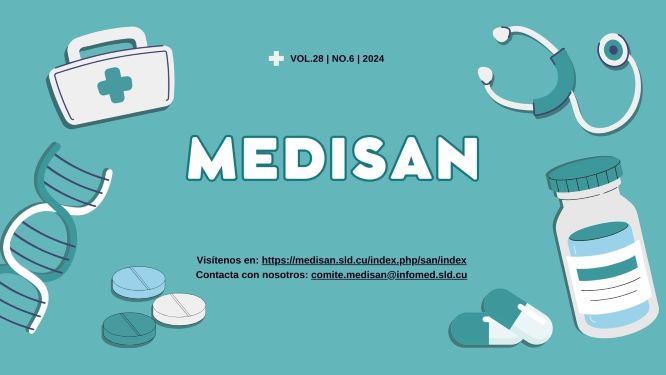Patients with dengue and signs of alarm during the epidemic of 2022 in Santiago de Cuba
Keywords:
dengue, signs of alarm, incidence, epidemic, Public Health.Abstract
Introduction: In 1981, Cuba registered its first epidemic of hemorrhagic dengue in America. Although in 1986 the transmitter mosquito was eliminated, a reinfestation happened in 1992. In 1997, dengue re-emerged with an epidemic outbreak in Santiago de Cuba municipality that included 3012 patients, 205 serious cases and 12 deaths. From then on, the new events in the region have been mainly associated with the DEN2 and DEN3 serotypes.
Objective: To describe the clinical-epidemiological characteristics of patients with dengue and signs of alarm during the epidemic of 2022.
Methods: A descriptive and cross-sectional study was carried out on 266 patients diagnosed with dengue and signs of alarm in Santiago de Cuba during 2022. The data were obtained from hospital reports that were sent to the Epidemiology Department of the Provincial Center of Hygiene, Epidemiology and Microbiology. The analyzed variables included age, sex, residence municipality and signs of alarm. Percentages and rates were used as summary measures.
Results: The highest incidences were found in patients under 15 years of age, especially in Santiago de Cuba, San Luis and Songo-La Maya. The most common signs of alarm were abdominal pain (54.1 %), vomits (44.3 %), marked weakness and placatopenia (22.5 %, respectively). The prevalent comorbidities included hypertension, diabetes mellitus and bronchial asthma.
Conclusions: The epidemic of 2022 was marked by the circulation of the DEN3serotype. The serious cases and signs of alarm were similar to previous outbreaks. Studies are required on the risk of comorbidities and medical training.
Downloads
References
2. Organización Panamericana de la Salud, Organización Mundial de la Salud. Dengue: Guías para la atención de enfermos en la Región de las Américas. 2ed. Washington, D.C:OPS/OMS;2015[citado 20/10/2023]. Disponible en: https://iris.paho.org/bitstream/handle/10665.2/28232/9789275318904_esp.pdf?sequence=1&isAllowed=y
3. Juventud Rebelde. Avanza desarrollo de vacuna cubana contra el dengue. Juventud Rebelde. 29 de enero de 2023[citado 20/10/2023]. Disponible en: https://www.juventudrebelde.cu/cuba/2023-01-28/avanza-desarrollo-de-vacuna-cubana-contra-el-dengue
4. Organización Panamericana de la Salud. Epidemiological Update Dengue in the Region of the Americas 28 March 2023. Washington. D.C:OPS; 2023[citado 15/04/2023]. Disponible en: https://reliefweb.int/attachments/a2c491e0-f265-451a-89ca-52d64ea497e0/2023march28pheepiupdatedengueen.pdf
5. Rigau Perez JG. Severe dengue: the need for new case definitions. Lancet Infect Dis. 2006;6(5):297-302.
6. Organización Mundial de la Salud, Programa Especial para la Investigación y Capacitación de Enfermedades Tropicales. Dengue, guías para el diagnóstico, tratamiento, prevención y control. Bolivia: OMS, TDR; 2009[citado 13/11/2023]. Disponible en: https://iris.who.int/bitstream/handle/10665/44504/9789995479213_spa.pdf?sequence=1&isAllowed=y
7. Organización Mundial de la Salud. Dengue y dengue grave. Ginebra: OMS;2024 [citado 13/05/2024]. Disponibe en: https://www.who.int/es/news-room/fact-sheets/detail/dengue-and-severe-dengue
8. Valdés García LE. Aportes al conocimiento del dengue y dengue hemorrágico en Santiago de Cuba [tesis doctoral]. La Habana: Instituto de Medicina Tropical Pedro Kouri; 2016[citado 11/11/2023]. Disponible en: https://tesis.sld.cu/index.php?P=DownloadFile&Id=49
9. Guzmán MG, Peláez O, Kourí G, Quintana I, Vázquez S, Pentón M, et al. Caracterización final y lecciones aprendidas de la epidemia de dengue 3 en Cuba, 2001-2002. Rev Panam Salud Publica. 2006[citado 20/11/2023];19(4):282-9. Disponible en: https://scielosp.org/pdf/rpsp/2006.v19n4/282-289/es
10. Organización Panamericana de la Salud, Organización Mundial de la Salud. Actualización epidemiológica semanal para dengue, chikunguña y zika en 2022. Boletín Arbovirusis. Washington, D.C: OPS/OMS;2022. Disponible en: https://www3.paho.org/data/index.php/es/temas/indicadores-dengue/boletin-anual-arbovirosis-2022.html
11. Arredondo García JL, Aguilar-López Escalera CG, Aguilar Lugo-Gerez JJ, Osnaya- Romero N, Pérez Guillé G, Medina-Cortina H. Panorama epidemiológico de dengue en México 2000–2019. Rev Latin Infect Pediatr. 2020[citado 20/11/2023];33(2):78-83. Disponible en: https://www.medigraphic.com/pdfs/infectologia/lip-2020/lip202d.pdf
12. George Carrión W, Bell Castillo J, García Céspedes ME, George Bell MJ. Aspectos clínico-epidemiológicos en pacientes con dengue y signos de alarma. Medisan (Santiago de Cuba). 2018[citado 05/12/2023];22(7):790. Disponible en: https://medisan.sld.cu/index.php/san/article/view/2218/html
13. Tamayo Escobar OE, García Olivera TM, Escobar Yéndez NV, González Rubio D, Castro Peraza O. Signos de alarma en pacientes cubanos con dengue según nueva clasificación revisada de la Organización Mundial de la Salud. Medisan (Santiago de Cuba). 2018[citado 08/12/2023];22(8). Disponible en: https://medisan.sld.cu/index.php/san/article/view/2284/html
14. Cotto JJ, Ronceros Medrano SG, Gómez García MD, Roby Arias AJ, Ordoñez Savala JM. Caracterización clínica del dengue con signos de alarma y grave, en hospitales de Guayaquil. Revista científica INSPILIP. 2017[citado 08/12/2023];1(1). Disponible en: https://docs.bvsalud.org/biblioref/2019/04/987761/29-caracterizacion-clinica-del-dengue-con-signos-de-alarma-y.pdf
15. Lugo S, Morilla L, Bejarano O, Basualdo W, Pavlicich V. Dengue con signos de alarma ¿Podemos predecir la evolución a grave desde la emergencia? Arch Pediatr Urug. 2016[citado 08/12/2023];87(2):178-85. Disponible en: https://www.sup.org.uy/archivos-de-pediatria/adp87-2/web/pdf/adp87-2_paraguay-dengue.pdf
16. Leon Ramentol CC, Betancourt Bethencourt JA, Nicolau Pestana E, Torres Tellez K. Biomarcadores para la predicción de la gravedad del dengue. Correo cient. méd. 2016[citado 15/12/2023];20(2):1560-4381. Disponible en: https://revcocmed.sld.cu/index.php/cocmed/article/view/2281/832
17. Kalayanarooj S, Nimmannitya S. Clinical an laboratory presentations of dengue patients with different serotypes. Dengue Bulletin. 2000[citado 20/12/2023];24:53-9. Disponible en: https://iris.who.int/bitstream/handle/10665/148790/dbv24p53.pdf?sequence=1
18. Nisalak A, Endy TP, Nimmannitya S, Kalayanarooj S. Serotype-specif dengue virus circulation and dengue disease in Bangkok, Thailand from 1973-1999. Am J Trop Med Hyg. 2003;68:191-202.
19. González Peralta J. Correlación entre las comorbilidades y las formas graves del dengue en los pacientes que ingresaron al Servicio de Urgencias del Hospital General de Cuernavaca en el periodo 01 de enero al 31 de diciembre del 2016[tesina]. Cuernavaca, Morelos: Universidad Autónoma del Estado de Morelos;2020[citado 20/12/2023]. Disponible en: http://riaa.uaem.mx/xmlui/bitstream/handle/20.500.12055/2308/JEGOPE01T.pdf?sequence=1&isAllowed=y
Downloads
Published
How to Cite
Issue
Section
License
All the articles can be downloaded or read for free. The journal does not charge any amount of money to the authors for the reception, edition or the publication of the articles, making the whole process completely free. Medisan has no embargo period and it is published under the license of Creative Commons, International Non Commercial Recognition 4.0, which authorizes the copy, reproduction and the total or partial distribution of the articles in any format or platform, with the conditions of citing the source of information and not to be used for profitable purposes.





